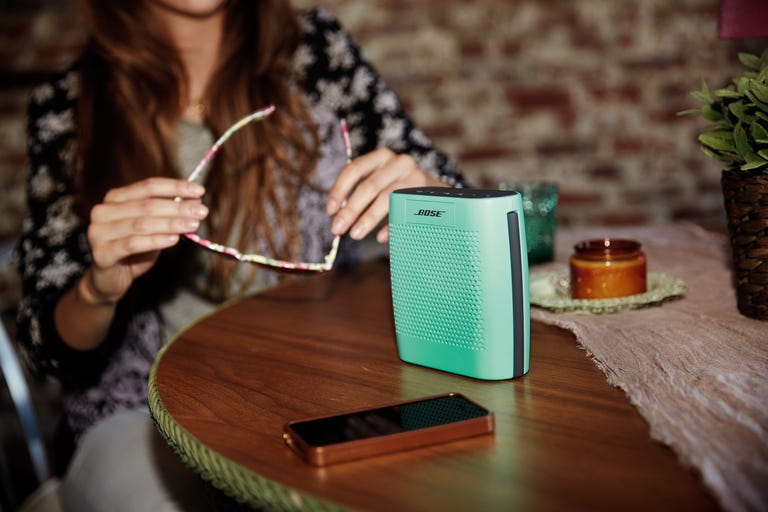 Why You Can Trust CNET
Why You Can Trust CNET Bose SoundLink Color review: A playful Bluetooth speaker that delivers serious sound for its size
Bose's lightest and least expensive wireless speaker stacks up well against against the competition.
As it heads into middle age, Bose, now 50 years old, is starting to break out of its conservative mold.
The Good
The Bad
The Bottom Line
Take the SoundLink Color, the company's lightest -- and least expensive -- portable Bluetooth speaker ($130, £120 in the UK, and AU$179 in Australia). As you might expect from a speaker called the Color, it comes in an array of palettes. Indeed, Bose seems to be targeting a younger demographic with its more playful design.
I personally like the blue model, but it's also available in black, white, blue, red and mint green. While it's compact, measuring 5.3 inches (13.5 cm) high, 5 inches (12.7 cm) wide, and 2.1 inches (5.3 cm) deep, it's got a little bit of heft to it, weighing 1.25 pounds (0.57 kg). Bose says it's designed "to fit easily into a handbag, knapsack or the palm of your hand," and it seems like it would be right at home in a kid's room or the kitchen.
Alas, no carrying case is included. And while it looks like it could be water-resistant, it isn't rated as such, leaving the audio input and USB ports on the back exposed.
As far as features go, Bose keeps things simple, with a pause/play button on top and volume controls but no speakerphone capabilities. The speaker remembers the last eight devices you've paired it with (complete with little artificial voice prompts when you turn it on), can pair with two devices at once (but only plays sound from one at a time), and gets up to 8 hours of battery life, which is pretty decent for a very compact
. I had no problem pairing it and re-pairing with both an iPhone 5S and a Samsung Galaxy S5 .Like the more expensive SoundLink Mini , the speaker plays a lot louder than you think it would for its small size, with a reasonable amount of bass. Soundwise, it's not on par with the Mini; that model offers better bass. However, unlike the older Bose -- which requires a proprietary AC adapter -- this newer model charges via a standard micro-USB cable (it takes about 3 hours to fully charge). That's much more convenient for traveling, especially if you have an Android phone.
Performance
Bose has done a good job eking out about the best sound you can expect from a speaker this size and placing it near a wall will help its bass performance. The speaker is designed to avoid distorting at higher volumes, so there are times when you push the volume that the music seems a little restrained and rolled off at certain frequencies. It also has a little trouble with more complicated music. And finally, although there are two drivers and a bass radiator, there's virtually no stereo separation, which is par for the course for this type of speaker.
I put it up against the $100 JBL Flip 2 , but spent the most time comparing it to the redesigned $150 JBL Charge 2, which I'm presently reviewing. (It's the sequel to the original JBL Charge .) The JBL serves up a good helping of bass, but it lacks clarity compared to the SoundLink Color, which is stronger in the midrange and treble. (The JBL does deliver better battery life, however, lasting up to 12 hours on one charge, and it can act as charger for your smartphone.)
The Bose did very well with simpler tracks and acoustic material. The vocals-only opening of David Byrne and St. Vincent's "Ice Age" track sounded great, but then fell down a bit as soon as the instruments kicked in. As I said, these types of speakers run into trouble resolving several instruments playing at once, and the SoundLink Color is no exception. But for its speaker class, it performs quite well and also plays loudly without distorting.
Conclusion
If your priority is sound quality, you're better off with the more expensive SoundLink Mini, which also has a more upscale metallic design. But if you value portability and don't want to spend the extra $70, the SoundLink Color is a solid choice. While not everybody will love its design, the majority of people should be impressed with the sound it puts out, particularly in smaller rooms.


